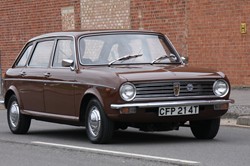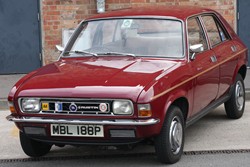Austin cars of the 1970s

Austin was part of British Leyland (BL) in the 1970s. BL brands in the 1970s were Austin, Morris, Jaguar, Rover, Triumph, MG, Wolesley and Vanden Plas.
Lord Stokes, BL's Chairman, split the company's bread and butter family cars into Austin and Morris. Unlike in the 1960s when both brands had sold near identical cars, apart from the badge, Austin and Morris had distinct images. Austin cars were technically advanced front-wheel drive cars. Morris cars were conventional rear-wheel drive cars with an eye to current automotive fashion.
This was most clearly illustrated in the difference between the front-wheel drive hatchback, five speed Austin Maxi and the rear-wheel drive saloon, the Morris Marina.
A complete list of Austin cars from the 1970s is:
- Mini 850 1969-83
- Mini 1000 1969-2000
- Mini Clubman 1969-1982
- Mini 1100 Special 1977-1981
- Mini 1275GT 1969-1980
- Austin 1100 MkII 1967-1971
- Austin 1100 MkIII 1971-1974
- Austin 1300 Mk II 1967-1971
- Austin 1300 Mk II 1971-1974
- Austin 1300GT 1969-1974
- Austin America 1968-71
- Austin Allegro 1973-1982
- Austin Maxi 1969 to 1981
- Austin 1800 MkII 1968-1972
- Austin 1800 MkIII 1972-1975
- Austin 1800 S 1969-1972
- Austin 2200 1972-1975
- Austin Princess 1975-1978
- Austin Princess 2 1978-1982
- Austin 3 litre 1967-1971
- Austin (Healey) Sprite Mk IV 1966-71
- Austin ¼ Ton Van 1963-71
- Austin ¼ Ton Pick-up 1963-71
Mini
Before 1969, Minis left the factory with an Austin or a Morris badge. BL rationalised the range in 1969 and 'Mini' itself became a brand. Both Austin and Morris dealers sold the Mini.
Mini 850 and Mini 1000
The new Mini became the MkIII. It got some useful improvements. New Minis had wind up windows for the first time and concealed door hinges. You could choose an 850cc or 1000cc The basic Mini was badged as Mini 850 or Mini 1000.
BL also sold the Mini Cooper 'S' with a tuned twin carburettor engine. The contract with John Cooper ended in 1971 and BL replaced the Mini Cooper 'S' with the 1275GT. The new sporty Mini had the Clubman body (see below), a single carburettor 1275cc engine and an improved dashboard with a rev counter.
Mini Clubman
The Clubman was a more up-market version of the Mini. It had a different squared off nose and different interior.
There was an estate version which replaced the previous Morris Mini-Traveller and Austin Mini Countryman. The original version had wood effect vinyl trim on the exterior to replace the real wood trim which was an option on the older cars.
Austin 1100 and Austin 1300
The 1100/1300 range was BMC's best-selling car from the 1960s. It was still doing well in the early 1970s.
In 1967 the Austin 1100 got a facelift and became the MkII. The Austin 1300 was introduced that year and also badged as a MkII.
Austin 1100 and Austin 1300 got a final facelift in 1972 and became the Mk III.
Austin 1300GT
Top of the 1100/1300 range was the 1300GT. Mechanically the Austin 1300GT was identical to the MG 1300.
It had a vinyl roof and was often supplied in bright 1970s' colours such as orange and purple. Under the bonnet was tuned 1275cc engine. Performance was just shy of 100mph and it had impressive acceleration of 0-60mph in 14 seconds.
Inside it had a black finish dashboard complete with rev counter and sports style steering wheel.
Austin America
The Austin America, introduced in 1968, continued only until 1971. See Austin cars from the 1960s for more details.
Austin Allegro

BL needed to find a replacement for the 1100/1300 range which was ten years old in 1972. Since this car represented a large proportion of their total sales, they needed to get it right. They did not.
In spite of being a new model the Allegro sold less well than the 1100/1300 range.
The original Allegro line up was:
- Allegro 1100
- Allegro 1300
- Allegro 1500
- Allegro 1750
The Allegro was meant to buck the trend for squared off cars with straight lines and look distinctive. Unfortunately people did not like it much. The car also offered little over the much-loved Austin 1100/1300 range and was more expensive. Loyal buyers deserted Austin dealerships, but those buying Morris 1100s moved over to the Marina which was doing well.
Austin Maxi
BL introduced the Maxi in 1969. The original package was a hatchback car with a five speed gearbox and a 1500cc engine. It had just one level of trim. The original styling did not appeal and BL revised in 1971.
The Maxi had a new grill and a wood finish fascia. Buyers also got the choice of a 1500cc or 1750cc engine.
In October 1972 BL introduced the range topping Maxi HL with a 1750cc engine with twin carburettors.
Austin 1800/2200
The Austin 1800 was introduced in 1964. It completed the series of Alec Issigonis designed front-wheel drive cars that started with the Mini.
The Austin 1100 was a scaled up Mini; the Austin 1800 was a scaled up Austin 1100. It received the B series engine originally used in the MGB, but in single carburettor form.
In 1970 the range was on the MkII. It had been smartened up with a new grill, a walnut finish dashboard and small tail fins.
In 1972 the range had another minor facelift. At the same time BL launched the Austin 2200 with a six cylinder 2200cc engine.
The Austin 1800 and 2200 were replaced by the Austin Princess in 1975.
Austin 3-litre
The ultimate expression of the Austin 1800 concept was the Austin 3-litre. It had a longer nose to accomodate a bigger engine and a longer tail for a bigger boot. Inside it was posh with plenty of walnut veneer. Unlike the Austin 1800 it was rear-wheel drive. Strangely it was less roomy than the smaller engined car because of the transmission tunnel.
Unsurprisingly, it did not sell well and the range was withdrawn in 1972.

Austin Princess
The Princess was BL's new wedge shaped saloon for the 1970s. There was a brand new stylish body and some new engines.
The Princess revived an old name, but there was nothing old fashioned about the style of the car. The new wedge shaped body, designed by Harris Mann, was up-to-the-minute.
Inside the cars were more luxurious than the outgoing Austin 1800/2200 range.
The Princess became the Princess 2 in 1978. The old B-series 1800cc engine was replaced by the 1.7 litre O-series fitted in the Marina Mk3. There was a new 2000cc derivative, but the six cylinder cars kept the old 2200cc engine.
Although the Princess was a good design (at least for the 1970s) and a better car than the Austin 1800, it only sold slightly better than the outgoing model and never beat the 1971 record sales figure for the Austin 1800. The reason was build quality. For a car with luxury pretentions, Leyland was not able to deliver. A hostile press, fond of Leyland bashing, did not help its cause.
In 1982 the Princess was replaced by the Austin Ambassador which had a similar styled body, but with a hatchback rear door.
Read more
- Austin cars from the 1960s
- Austin cars from the 1980s
- Ford cars from the 1970s
- Vauxhall cars from the 1970s


Comments